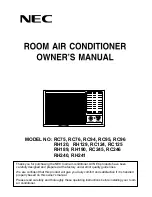
14
22
CONNECTOR
ORIENTATION
(side view)
NOTE: SPLASH COVER NOT SHOWN FOR CLARITY.
Nota: Para mayor claridadno se muestra la tapa protectora.
.
WATER PROBE
Sonda
del agua
MINIMUM SPEED
ADJUST
Ajuste de la velocidad
PUMP
DRAIN
Valvula
de drenaje
INLET
E
ntrada
del agua
RECEIVER
Receptor
DIAGNOSTIC
LED’S
LED’
s de diagnóstico
Bomba
ILL1392-A
O
rientación del
conectador
(vista lateral)
MOTOR POWER (AMPS)
Important: Install all the pad frames
except the one on the motor side.
Beware of rotating fan, belt
and pulleys whilst making adjustments
to motor speed, pulley or belt tension
settings. Ensure the cooler is switched
OFF via the electronic module
isolation switch whilst working inside
the cooler.
Motor load must be
checked
the pump running.
This
should be done by a trained licensed
electrician.
Ensure that all intended doors, windows
or other means of exhaust are open in the
building, and that all outlet grilles are
open fully.
Set the cooler running at the highest
speed for about 10 minutes, or until the
motor has reached its normal operating
temperature (hot!).
Clip your ammeter onto the free cable in
the main termination box. (Fig. 23)
WARNING:
without
23
For convenience, the rated motor
current, in amps, is printed on a small
label attached near the cable fork (in
addition to the normal motor
nameplate label located at the back of
the motor).
Check the measured amps against the
.
motor nameplate amps
If the measured
amps are less than the nameplate amps the
adjustable motor pulley sheave must be
altered to increase the fan speed, thereby
delivering the full capability of the cooler to
your installation.
If the measured amps are greater than the
motor nameplate amps the fan MUST be
slowed down by adjusting the motor pulley
sheave in the opposite manner.
Replace all covers when adjustments are
completed using the screws provided
The measured amps must
be equal or close to, but never more than
the nameplate amps. (see heading
"Pulley (Sheave) Adjustment")
Failure to
do this will cause overheating in the
motor and may cause the motor
’
s thermal
protector to trip.
PULLEY (SHEAVE) ADJUSTMENT
DO NOT USE THE PULLEY ADJUSTMENT
TO SET BELT TENSION.
The motor pulley is adjustable in order to set
the motor amperes at the correct
(nameplate) level, and thus provide the
owner with full machine cooling capacity.
The adjustment is made with the cooler
switched OFF. Never attempt this procedure
with the cooler operating.
Remove the drive belt.
To increase the fan speed (and therefore the
motor amps), the two halves of the pulley
must be closer together, ie: turn the
adjustable half clockwise. (Fig. 24)
To decrease the fan speed (and therefore
the motor amps), the two halves of the pulley
must be further apart, ie: turn the adjustable
half counter-clockwise. (Fig. 24)
A = Fixed Sheave
B = Grub Screw
C = Adjustable Sheave
D = Locking Cap
E = Locking Cap Screw
24
The outer half of the pulley is on a
thread and can be moved in or out by
removing the locking cap and then
turning the outer half by hand in the
desired direction.
When an adjustment is made, replace
the locking cap, aligning the screw
hole with the nearest hole in the
adjustable half. Lock it into place with
the securing screw. Refit the belt,
reset the belt tension, then run the
cooler and check the amps. Repeat
the process until the amp level is set.
You can start and stop the cooler for
this procedure by using the isolating
switch inside the cooler.
If it is too
tight there will be excessive belt and
bearing wear. If it is too loose there
will be belt slip, excessive belt wear
and loss of cooler performance.
There are two adjuster bolts with
locking nuts attached to the motor
mounting.
The tension should be adjusted so
that the deflection on one side of the
belt is 5/8" to 13/16". To make the
adjustment, loosen the locking nuts
and screw the bolts in or out as
required to change the belt tension.
Re-tighten the locking nuts.
It is important to recheck the motor
amps again after re-setting the belt
tension.
Correct belt tension ensures the belt
will not slip. Check the temperature of
the belt by hand after each
adjustment, by turning off the cooler
and holding one side of the belt in
your hand. If the belt is warm to touch,
it is slipping! Continue to tighten until
it runs cool. (Fig. 25)
BELT TENSION
Belt tension is important.
25
12
15
EXV Evaporative Cooler
Installation Details









































